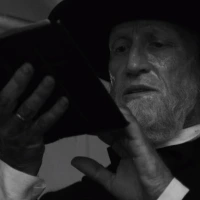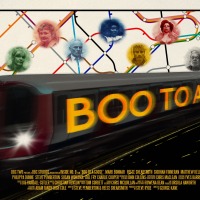 Warner Bros. Home Entertainment, out now on Digital and available on Blu-ray™ Steelbook, Blu-ray™ and DVD May 14.
Warner Bros. Home Entertainment, out now on Digital and available on Blu-ray™ Steelbook, Blu-ray™ and DVD May 14.
Gorilla Grodd’s time displacement machine transports many of Batman’s worst enemies to feudal Japan – along with the Dark Knight and a few of his allies.
East meets West in animation terms is hardly a new idea – for decades now, western characters have been given an anime make-over, and indeed it often happens the other way around (rarely as successfully though). So, the idea of handing Batman and his supporting cast lock stock and barrel to a trio of Japanese studios, none of whom have a huge international renown, might have seemed either daring or insane to Warner Brothers. But throw in JoJo’s Bizarre World director Junpei Mizusaki and a script by Kazuki Nakashima and we should have a winner. So: do we?
Well, yes and no. If one is solely looking for familiar anime tropes (random J-pop, big mecha robot power-ups, crazy re-designs of established characters and brilliant animation), then it’s an absolute winner. But where Batman Ninja falls down ever so slightly (luckily, it’s more a steady stumble than a death drop) is the story. It’s meandering, overlong and has (unusually for Japanese anime) zero heart or soul. It’s not a story about anything, it has no message. Bruce Wayne at one point looks at his hand and muses that stripped of his technology and weapons, who is he? Well, fundamentally, he’s actually still Batman – his weapons and Batmobile have aided him absolutely, but it’s a central flaw in the premise of this story that without these things, he must strip himself back to pre-industrial-age thinking to find himself again. That’s nonsense.
 And this build-up-to-one-revelationary-beat is a basic flaw throughout. At the start of the story, we see Bats and his friends and foes sent back in time to feudal Japan (it’s pretty unfeudal actually, once you take out Deathstroke, Poison Ivy, Two-Face, Penguin, Grodd and the Joker). Bats comments at one point that the Joker is interfering with history by inventing steam/combustion engines before their time. Not original, but an interesting idea anyway. It’s never featured again after that and all we see is the result of this – the aforementioned mecha which are giant castles given mobility – but there’s no effect on Japanese life. Well apart from the hypocrisy of Bats then driving his gas-guzzling Batmobile through the rice fields (he never stops to think what he’s going to do once he runs out of fuel).
And this build-up-to-one-revelationary-beat is a basic flaw throughout. At the start of the story, we see Bats and his friends and foes sent back in time to feudal Japan (it’s pretty unfeudal actually, once you take out Deathstroke, Poison Ivy, Two-Face, Penguin, Grodd and the Joker). Bats comments at one point that the Joker is interfering with history by inventing steam/combustion engines before their time. Not original, but an interesting idea anyway. It’s never featured again after that and all we see is the result of this – the aforementioned mecha which are giant castles given mobility – but there’s no effect on Japanese life. Well apart from the hypocrisy of Bats then driving his gas-guzzling Batmobile through the rice fields (he never stops to think what he’s going to do once he runs out of fuel).
Then, halfway through the story, we have a brief change of pace and animation style, as Red Hood (Todd version) goes a-hunting for the Joker and Harley and beats the crap out of them. It’s not just the change of animation that’s jarring, it’s the ethos of the whole section. Cutting it out (and changing a couple of lines of dialogue later) would have reduced the running time nicely and saved a massive “so what” moment.
 But there are hundreds of things to recommend this movie above the weak story. The animation is flawless, the backgrounds are beautiful (look for the dew drops on blades of grass – such detail is astonishing) and the character designs are, for the most part, gorgeous. The Joker has rarely looked better, nor has Two-Face. Ivy, Penguin and Deathstroke are little more than cameos really, but look good all the same. The various Robins (Red Robin – Drake version – especially) all look great and heroic and sexy as anime heroes always do
But there are hundreds of things to recommend this movie above the weak story. The animation is flawless, the backgrounds are beautiful (look for the dew drops on blades of grass – such detail is astonishing) and the character designs are, for the most part, gorgeous. The Joker has rarely looked better, nor has Two-Face. Ivy, Penguin and Deathstroke are little more than cameos really, but look good all the same. The various Robins (Red Robin – Drake version – especially) all look great and heroic and sexy as anime heroes always do
There are delightful artistic flourishes – Hokusai’s famous wave is in there, and Robin (Damian version)’s friend Monkichi’s nod to Masako Natsume’s Monkey is delightful. Most fun of all is the giant powered-up Batman (made from bats and monkeys – you need to see it to get that) is a sweet homage to Lewis Wilson’s ’40s Batman film series.
I suspect the biggest round of applause must go to Leo Chu and Eric S. Garcia. Older readers will no doubt remember ’60s puppet series The Magic Roundabout, where UK writer Eric Thompson was handed a load of mute French episodes and had to write scripts based upon what he saw. Chu and Garcia have a similar job here – the Japanese version (available via the Extras) is scant on dialogue and what there is, doesn’t help them at all. So, using the film as they saw it, the two Americans had to write an estimated 90% new dialogue and shape the film for the western audiences. That they do it really well is huge kudos to them.
Verdict: After the Adam West animations and the superb Gotham by Gaslight earlier this year, Batman Ninja is a bit of a backward step – visually, it is stunning (thanks no doubt to Mizusaki), but the story is weak and uneven and no matter how crisp the dialogue is (and “It’s time for some girl on girl action” may raise a slight smile, but in a post-#MeToo world, it’s probably not entirely worth cheapening things by chucking the line in there), it can’t cover up the overall disappointment, especially in the second half, that Batman Ninja ultimately delivers. 6/10
Gary Russell













